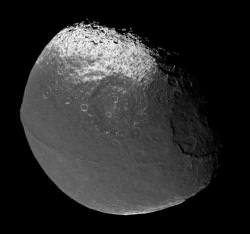NASA’s Cassini spacecraft is going to make one of its most important flybys of its entire mission this week, zipping past Saturn’s moon Iapetus on September 10th, 2007. I’m calling it “most important”, not NASA, but trust me, this is a big one. I’ve got two reasons for this: it’s the first time Cassini will get this close to Iapetus, and this moon is one of the strangest objects in the Solar System, with a whole collection of bizarre features.
First let’s talk about Iapetus. This is one bizarre moon. Take a look at the picture and you’ll see that it’s got what looks like a seam running across its equator. That’s not a seam, but a bizarre mountain range that runs across its equator. This ridge is 20 km (12 mile) wide and 13 km (8 mile) high, extending 1,300 km (800 miles) directly along the moon’s equator.
It’s possible that this ridge was created when the moon was spinning much more quickly than it does today. Or maybe this is some kind of icy material that welled up from within the moon and then solidified on the surface. Or perhaps the moon consumed one of Saturn’s rings, piling the material up on its surface along the equator. Whatever the case, it’s one of the strangest features in the Solar System.
Second, Iapetus has two completely different coloured hemispheres: one bright as snow and the other dark. The dark material might have come from another of Saturn’s moons, or maybe it’s organic material that rained down in the past. Perhaps it’s material that came out from the middle and hardened. But what is it? You see, this place is mysterious.
Third, it’s shaped like a walnut. You can see the strange shape just in the picture. That’s not a trick of the camera, the moon really is squashed like that. Like someone tore it in half, and then smashed it back together again. What caused it? How did it stay that way, and not turn back into a sphere?
NASA’s Voyager 2 flew past Iapetus on August 22, 1981 at a range of 966,000 km (600,000 miles) and turned up the strange shape and dark/light hemispheres. On December 31st, 2004, Cassini made its first close approach getting within 123,000 km (77,000 miles), and taking the picture I’ve attached with this story.
Well, on September 10th, 2007, Cassini will fly only 1,200 km (800 miles) above Iapetus and take its highest resolution pictures ever. Finally, I’ll get my answers. And probably a few new questions too.
I can’t wait.
Original Source: NASA/JPL/SSI News Release

